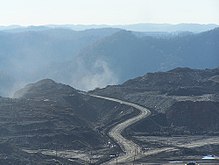

Mountaintop removal mining (MTR), also known as mountaintop mining (MTM), is a form of surface mining at the summit or summit ridge of a mountain. Coal seams are extracted from a mountain by removing the land, or overburden, above the seams. This process is considered to be safer compared to underground mining because the coal seams are accessed from above instead of underground. In the United States, this method of coal mining is conducted in the Appalachian Mountains in the eastern United States. Explosives are used to remove up to 400 vertical feet (120 m) of mountain to expose underlying coal seams. Excess rock and soil is dumped into nearby valleys, in what are called "holler fills" ("hollow fills") or "valley fills".[1][2][3]
The practice of MTM has been controversial. While there are economic benefits to this practice as well as important contributions to the availability of affordable energy, there are also concerns for environmental and human health costs. Recognizing mountaintop removal as a "humanitarian crisis," members of Congress with the support of Appalachian residents introduced the ACHE ACT in 2012 to enact a moratorium on the mining practice until a health report could be undertaken. Author and journalist Jeff Biggers, who covered the coal mining industry in his Reckoning in Appalachia reports for 25 years, called mountaintop removal "an immoral crime against nature and our citizenry, and it must be abolished, not regulated.”
- ^ "Appeals Court Upholds Mountaintop Removal Mining". www.ens-newswire.com. Retrieved 19 June 2017.
- ^ U.S. Environmental Protection Agency, "Mountaintop Mining/Valley Fills in Appalachia: Final Programmatic Environmental Impact Statement," issued 2005 June 25, available at http://www.epa.gov/region03/mtntop/index.htm (accessed 2006 August 20).
- ^ "Mountaintop Mining and Valley Fills in Appalachia (MTM/VF) - Programmatic Environmental Impact Statement". Retrieved 19 June 2017.